Elegant French actress Arlette Marchal (1902-1984) started her career in 1920 as a mannequin, and from the 1950s on she dedicated herself to her fashion enterprise. In between Marchal starred in 41 European and American films.

French postcard by J.R.P.R., Paris, no. 308. Arlette Marchal as Rosine in the French silent film Figaro (Gaston Ravel, 1929), based on the play by Beaumarchais.

French postcard by A.N., Paris, no. 176. Photo: G.L. Manuel Frères.
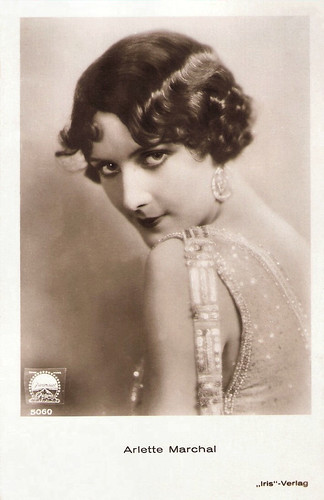
Austrian postcard by Iris Verlag, no. 5060. Photo: Paramount.
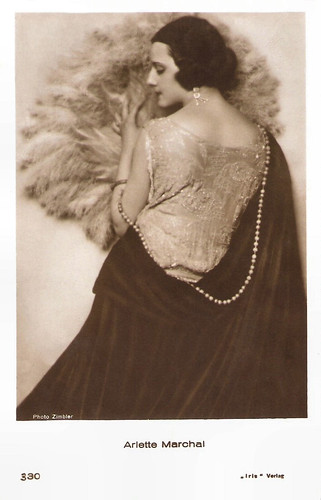
Austrian postcard by Iris Verlag, no. 330. Photo: Zimbler.
Arlette Marchal was born Lucienne Marie Marchal in Paris in 1902. She started her career as a mannequin at the fashion salon Jenny in 1920. A year later, she won a beauty contest in Aix-les-Bains.
Head of the jury was film director Leonce Perret. This resulted in film offers in melodramas, costume dramas and comedies. Often she played classy ladies in films like Mon p'tit/My Little One (René Plaissette, 1922), Un coquin/A Rascal (Giuseppe Guarino, 1923) with Iván Petrovich, and Un drame au Carlton Club/A Tragedy at the Carlton Club (Giuseppe Guarino, 1924).
Then Marchal started to perform in films abroad. First, she played in the Franco-Austrian production Das Bildnis/L'Image (Jacques Feyder, 1924), based on a novel by Jules Romains. She became good friends with Jacques Feyder and his wife Françoise Rosay. Next, she played in the French production Terreur/Terror (Gérard Bourgeois, Edward José, 1924) with American serial queen Pearl White in the female lead.
In Vienna, she played with Maria Corda in the British-Austrian epic Die Sklavenkönigin/The Slave Queen (Michael Kertesz, later Michael Curtiz, 1924). This was followed by the French super-production Madame Sans-Gêne (Léonce Perret, 1924). Marchal played the Queen of Naples opposite Gloria Swanson, who played the title role.
In 1925, Marchal was in Britain for Venetian Lovers (Walter Niebuhr, Frank A. Tilley, 1925). Then she played in the French production La chatelaine du Liban/Milady of Liban (Marco de Gastyne, 1926), again with Iván Petrovich. In the meantime, Gloria Swanson had convinced Marchal to come over to Hollywood, which she did. Marchal also met and fell in love with director Marcel de Sano. The two married in 1928.
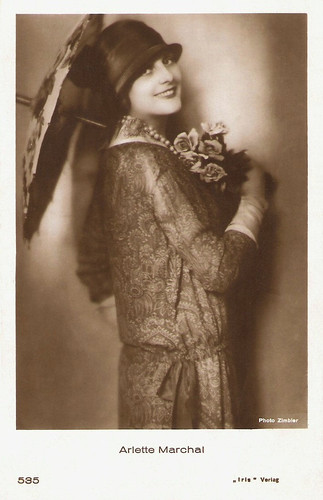
Austrian postcard by Iris Verlag, no. 353. Photo: Zimbler.

French postcard by Europe, no. 173. Photo: Société des Cinéromans.
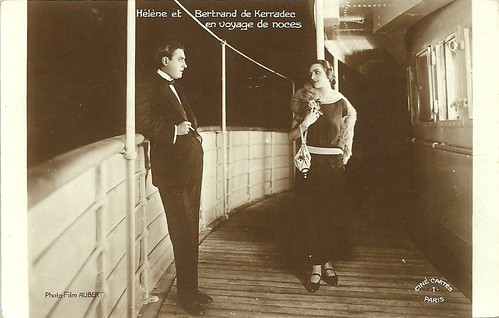
French postcard by Editions Cinémagazine, Ciné-Cartes, Paris, no. 1. Photo: Film Aubert. Arlette Marchal and André Feramus in Sarati, le terrible / Sarati the Terrible (René Hervil, Louis Mercanton, 1923).
From 1926 on, Arlette Marchal performed in various American productions such as Born to the West (John Waters, 1926) in which Jack Holt had the male lead and she was Belle of the Paradise Bar.
This was followed by The Cat's Pajamas (William Wellman, 1926) starring Betty Bronson and Ricardo Cortez, Diplomacy (Marshall Neilan, 1926), Forlon River (John Waters, 1926) again with Holt, and Blonde or Brunette (Richard Rosson, 1926) with Adolphe Menjou and Greta Nissen.
In 1927 Marchal played in one French film, the Horror film Le manoir de la peur/The Manor House of Fear (Alfred Machin, 1927), after which she continued in Hollywood with a modest role in William Wellman's super production Wings (1927) about pilots in World War One (Buddy Rogers, Richard Arlen) and their girl friends (Clara Bow and Jobyna Ralston).
Marchal played again with Bow in Hula (Victor Fleming, 1927) and with Menjou in A Gentleman of Paris (Harry d'Abbadie d'Arrast, 1927).
After The Spotlight (Frank Tuttle, 1927) with Esther Ralston, Marchal returned to Europe. No doubt because of the introduction of sound in the American cinema and her French accent.

Italian postcard by Ed. A. Traldi, Milano, no. 850. Arlette Marchal in La Châtelaine du Liban/Milady of Liban (Marco de Gastyne, 1926), based on the novel by Pierre Benoit.

German postcard by Ross Verlag, Berlin, no. 1704/1, 1927-1928. Photo: FaNaMet.
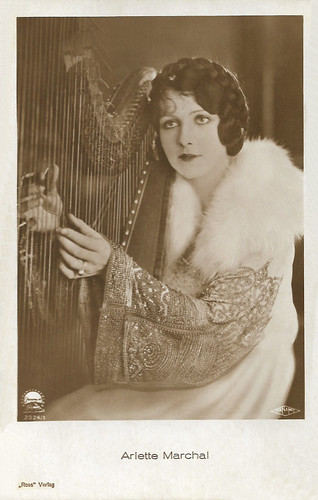
German postcard by Ross Verlag, no. 2024/1, 1927-1928. Photo: Paramount.

Vintage postcard. Collection: Didier Hanson.
Back in Europe, Arlette Marchel first made a film in Austria, Die Frau von gestern und morgen/The Woman of Yesterday and Tomorrow (Heinz Paul, 1927), and a Ufa production in Berlin, Die Dame mit der Maske/The Lady with the Mask (Wilhelm Thiele, 1928). She made her two last silent films in France: La femme revee/An Ideal Woman (Jean Durand, 1928) and Figaro (Gaston Ravel, Tony Lekain, 1929).
Then sound film also set in in France and Marchal continued her career there. Between 1931 and 1934 she played parts in films, though less frequently. For instance, she appeared as the Duchess in Georg Wilhelm Pabst's Don Quichotte (1933) starring Feodor Chaliapin. Marchal played both in the German and the French version of this multilingual. Other roles were a.o. in Boudoir diplomatique/The Boudoir Diplomat (Marcel de Sano, 1931) with Ivan Petrovich, La poule/The Hen (René Guissart, 1932), Le petit roi/The Little King (Julien Duvivier, 1933) with Marie Glory, Toboggan (Henri Decoin, 1934), and La marche nuptiale/Wedding March (Mario Bonnard, 1935) with Madeleine Renaud.
In 1936, however, a terrible car accident killed Marcel De Sano. It proved to have been suicide, as De Sano was found with a rubber pipe in his mouth. Marchal and De Sano had become estranged, and he had an affair with Jeanette McDonald, whose European career he took care of. Marchal was so shocked by his death that she shut herself up for over two years. Then she retook her film work, and she also began to appear on stage. Her film roles became scarce. In 1939, she made two films: Entente cordiale/Cordial agreement (Marcel L'Herbier, 1939) with Gaby Morlay, and La loi du nord/The Law of the North (Jacques Feyder, 1939) starring Michèle Morgan.
During the war, she appeared in two more films. She had a minor role in Le journal tombe a cinq heures/The newspaper falls at five o'clock (Georges Lacombe, 1942) and she played the Russian tsarina in the Leo Tolstoy adaptation Le père Serge/Father Serge (Lucien Ganier-Raymond, 1945). After the war, Marchal played once more the aristocrat in The Elusive Pimpernel/The Fighting Pimpernel (Michael Powell, Emeric Pressburger, 1950), starring David Niven. Her last film role was in the comedy ...Sans laisser d'adresse/Without leaving of address (Jean-Paul Le Chanois, 1951) with Bernard Blier.
In 1960, she did one last stage role in Tovaritch, directed by Jacques Deval at the Théâtre de Paris. From the 1940s on, Marchal had dedicated herself mostly to her fashion enterprise. In 1976 she became Chevalier des Arts et des Lettres. Arlette Marchal died in 1984 in Paris.
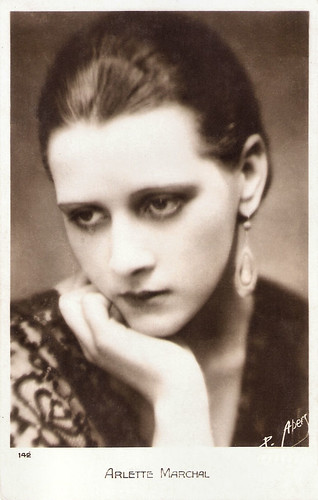
French postcard by Cinémagazine Edition, Paris, no. 142. Photo: P. Abers.

French postcard by J.R.P.R., Paris, no. 305. Publicity still for Figaro (1929) with Tony D'Algy.
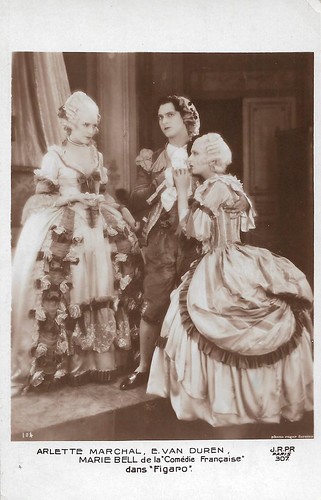
French postcard by J.R.P.R., Paris, no. 307. Photo: Roger Forster. Ernst/Edmond Van Duren, Arlette Marchal, and Marie Bell in Figaro (Gaston Ravel, 1929), based on the play by Beaumarchais.

French postcard by Editions Cinémagazine (EC), no. 20. Photo: Arnal.
Sources: Thomas Staedeli (Cyranos), CineArtistes.com, Wikipedia and IMDb.
This post was last updated on 5 May 2025.

French postcard by J.R.P.R., Paris, no. 308. Arlette Marchal as Rosine in the French silent film Figaro (Gaston Ravel, 1929), based on the play by Beaumarchais.

French postcard by A.N., Paris, no. 176. Photo: G.L. Manuel Frères.

Austrian postcard by Iris Verlag, no. 5060. Photo: Paramount.

Austrian postcard by Iris Verlag, no. 330. Photo: Zimbler.
The queen of Naples
Arlette Marchal was born Lucienne Marie Marchal in Paris in 1902. She started her career as a mannequin at the fashion salon Jenny in 1920. A year later, she won a beauty contest in Aix-les-Bains.
Head of the jury was film director Leonce Perret. This resulted in film offers in melodramas, costume dramas and comedies. Often she played classy ladies in films like Mon p'tit/My Little One (René Plaissette, 1922), Un coquin/A Rascal (Giuseppe Guarino, 1923) with Iván Petrovich, and Un drame au Carlton Club/A Tragedy at the Carlton Club (Giuseppe Guarino, 1924).
Then Marchal started to perform in films abroad. First, she played in the Franco-Austrian production Das Bildnis/L'Image (Jacques Feyder, 1924), based on a novel by Jules Romains. She became good friends with Jacques Feyder and his wife Françoise Rosay. Next, she played in the French production Terreur/Terror (Gérard Bourgeois, Edward José, 1924) with American serial queen Pearl White in the female lead.
In Vienna, she played with Maria Corda in the British-Austrian epic Die Sklavenkönigin/The Slave Queen (Michael Kertesz, later Michael Curtiz, 1924). This was followed by the French super-production Madame Sans-Gêne (Léonce Perret, 1924). Marchal played the Queen of Naples opposite Gloria Swanson, who played the title role.
In 1925, Marchal was in Britain for Venetian Lovers (Walter Niebuhr, Frank A. Tilley, 1925). Then she played in the French production La chatelaine du Liban/Milady of Liban (Marco de Gastyne, 1926), again with Iván Petrovich. In the meantime, Gloria Swanson had convinced Marchal to come over to Hollywood, which she did. Marchal also met and fell in love with director Marcel de Sano. The two married in 1928.

Austrian postcard by Iris Verlag, no. 353. Photo: Zimbler.

French postcard by Europe, no. 173. Photo: Société des Cinéromans.

French postcard by Editions Cinémagazine, Ciné-Cartes, Paris, no. 1. Photo: Film Aubert. Arlette Marchal and André Feramus in Sarati, le terrible / Sarati the Terrible (René Hervil, Louis Mercanton, 1923).
Belle of the Paradise Bar
From 1926 on, Arlette Marchal performed in various American productions such as Born to the West (John Waters, 1926) in which Jack Holt had the male lead and she was Belle of the Paradise Bar.
This was followed by The Cat's Pajamas (William Wellman, 1926) starring Betty Bronson and Ricardo Cortez, Diplomacy (Marshall Neilan, 1926), Forlon River (John Waters, 1926) again with Holt, and Blonde or Brunette (Richard Rosson, 1926) with Adolphe Menjou and Greta Nissen.
In 1927 Marchal played in one French film, the Horror film Le manoir de la peur/The Manor House of Fear (Alfred Machin, 1927), after which she continued in Hollywood with a modest role in William Wellman's super production Wings (1927) about pilots in World War One (Buddy Rogers, Richard Arlen) and their girl friends (Clara Bow and Jobyna Ralston).
Marchal played again with Bow in Hula (Victor Fleming, 1927) and with Menjou in A Gentleman of Paris (Harry d'Abbadie d'Arrast, 1927).
After The Spotlight (Frank Tuttle, 1927) with Esther Ralston, Marchal returned to Europe. No doubt because of the introduction of sound in the American cinema and her French accent.

Italian postcard by Ed. A. Traldi, Milano, no. 850. Arlette Marchal in La Châtelaine du Liban/Milady of Liban (Marco de Gastyne, 1926), based on the novel by Pierre Benoit.

German postcard by Ross Verlag, Berlin, no. 1704/1, 1927-1928. Photo: FaNaMet.

German postcard by Ross Verlag, no. 2024/1, 1927-1928. Photo: Paramount.

Vintage postcard. Collection: Didier Hanson.
The Russian Tsarina
Back in Europe, Arlette Marchel first made a film in Austria, Die Frau von gestern und morgen/The Woman of Yesterday and Tomorrow (Heinz Paul, 1927), and a Ufa production in Berlin, Die Dame mit der Maske/The Lady with the Mask (Wilhelm Thiele, 1928). She made her two last silent films in France: La femme revee/An Ideal Woman (Jean Durand, 1928) and Figaro (Gaston Ravel, Tony Lekain, 1929).
Then sound film also set in in France and Marchal continued her career there. Between 1931 and 1934 she played parts in films, though less frequently. For instance, she appeared as the Duchess in Georg Wilhelm Pabst's Don Quichotte (1933) starring Feodor Chaliapin. Marchal played both in the German and the French version of this multilingual. Other roles were a.o. in Boudoir diplomatique/The Boudoir Diplomat (Marcel de Sano, 1931) with Ivan Petrovich, La poule/The Hen (René Guissart, 1932), Le petit roi/The Little King (Julien Duvivier, 1933) with Marie Glory, Toboggan (Henri Decoin, 1934), and La marche nuptiale/Wedding March (Mario Bonnard, 1935) with Madeleine Renaud.
In 1936, however, a terrible car accident killed Marcel De Sano. It proved to have been suicide, as De Sano was found with a rubber pipe in his mouth. Marchal and De Sano had become estranged, and he had an affair with Jeanette McDonald, whose European career he took care of. Marchal was so shocked by his death that she shut herself up for over two years. Then she retook her film work, and she also began to appear on stage. Her film roles became scarce. In 1939, she made two films: Entente cordiale/Cordial agreement (Marcel L'Herbier, 1939) with Gaby Morlay, and La loi du nord/The Law of the North (Jacques Feyder, 1939) starring Michèle Morgan.
During the war, she appeared in two more films. She had a minor role in Le journal tombe a cinq heures/The newspaper falls at five o'clock (Georges Lacombe, 1942) and she played the Russian tsarina in the Leo Tolstoy adaptation Le père Serge/Father Serge (Lucien Ganier-Raymond, 1945). After the war, Marchal played once more the aristocrat in The Elusive Pimpernel/The Fighting Pimpernel (Michael Powell, Emeric Pressburger, 1950), starring David Niven. Her last film role was in the comedy ...Sans laisser d'adresse/Without leaving of address (Jean-Paul Le Chanois, 1951) with Bernard Blier.
In 1960, she did one last stage role in Tovaritch, directed by Jacques Deval at the Théâtre de Paris. From the 1940s on, Marchal had dedicated herself mostly to her fashion enterprise. In 1976 she became Chevalier des Arts et des Lettres. Arlette Marchal died in 1984 in Paris.

French postcard by Cinémagazine Edition, Paris, no. 142. Photo: P. Abers.

French postcard by J.R.P.R., Paris, no. 305. Publicity still for Figaro (1929) with Tony D'Algy.

French postcard by J.R.P.R., Paris, no. 307. Photo: Roger Forster. Ernst/Edmond Van Duren, Arlette Marchal, and Marie Bell in Figaro (Gaston Ravel, 1929), based on the play by Beaumarchais.

French postcard by Editions Cinémagazine (EC), no. 20. Photo: Arnal.
Sources: Thomas Staedeli (Cyranos), CineArtistes.com, Wikipedia and IMDb.
This post was last updated on 5 May 2025.
9 comments:
Sultry! Always a joy to visit with you and learn a little more about film stars!
Arlette Marchal is a true beauty... born in my favorite city... Paris. Who would have thought starting as a mannequin would lead to such a successful career!
Wonderful post. TFS. Happy PFF!
Before I started reading your write-up, I thought what beautiful dresses. Then I started reading and understood why!
Yes - sultry is what I thought as well. Beautiful lady - looks a bit Garboesque in the last shot
Beautiful clothing and hair styles back in those days. So glamorous.
This is a fantastic blog.
How come you know so much, and (many of) us know so little about your subjects? :)
Please research some Romanian(-born) actors and actresses.
:)
Thank you all for stopping by.
Hi Dorincard, I would like to research some Romanian actors. There is already a post on Elvire Popesco (1894-1993), a French actress of Romanian origin. Do you have suggestions?
Bob
Talking about Romanian descent actors, well, in this case film directors, Arlette's husband Marcel de Sano was Romanian (Marcel Dragusanu)
Post a Comment